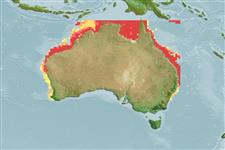Environment: milieu / climate zone / depth range / distribution range
Ökologie
seewasser demersal; tiefenbereich 11 - 120 m (Ref. 86942). Tropical; 11°S - 35°S, 112°E - 154°E
Indo-West Pacific: known only from Australian waters. Records from the western Indian Ocean are misidentifications of Parapercis robinsoni (Ref. 42740).
Size / Gewicht / Alter
Maturity: Lm ? range ? - ? cm
Max length : 25.0 cm TL Männchen/unbestimmt; (Ref. 42740)
Body whitish with 6 large quadrangular brown spots on back (may contain small pale blotches and may be red in fish from deep water) and a second series of 6 similar but more round dark spots on lower side of body. Body not very elongate (depth 4.7 to 6.1 in SL). Head with blue lines extending anteriorly from eye and across interorbital. Spinous portion of dorsal fin black between first and fifth spines (Ref 42740).
Found on silty sand and rubble bottoms in shallow bays (Ref. 42740). Feeds on small crustaceans (Ref. 394).
Life cycle and mating behavior
Geschlechtsreife | Fortpflanzung | Ablaichen | Eier | Fecundity | Larven
Allen, G.R. and R. Swainston, 1988. The marine fishes of north-western Australia: a field guide for anglers and divers. Western Australian Museum, Perth. 201 p. (Ref. 3132)
IUCN Rote Liste Status (Ref. 130435)
Bedrohung für Menschen
Harmless
Nutzung durch Menschen
Aquarium: Kommerziell
Mehr Information
NamenSynonymeMetabolismusRäuberÖkotoxikologieFortpflanzungGeschlechtsreifeAblaichenSpawning aggregationFecundityEierEientwicklung
ReferenzenAquakulturAquakultur ProfilZuchtlinienGenetikElectrophoresesVererbbarkeitKrankheitenVerarbeitungNutrientsMass conversion
Tools
Zusatzinformationen
Download XML
Internet Quellen
Estimates based on models
Preferred temperature (Ref.
123201): 23.6 - 28.7, mean 27.1 °C (based on 414 cells).
Phylogenetic diversity index (Ref.
82804): PD
50 = 0.5000 [Uniqueness, from 0.5 = low to 2.0 = high].
Bayesian length-weight: a=0.00692 (0.00311 - 0.01538), b=3.06 (2.88 - 3.24), in cm total length, based on LWR estimates for this Genus-body shape (Ref.
93245).
Trophic level (Ref.
69278): 3.5 ±0.50 se; based on food items.
Widerstandsfähigkeit (Ref.
120179): mittel, Verdopplung der Population dauert 1,4 - 4,4 Jahre. (Preliminary K or Fecundity.).
Fishing Vulnerability (Ref.
59153): Low vulnerability (15 of 100).
Nutrients (Ref.
124155): Calcium = 196 [121, 337] mg/100g; Iron = 1.14 [0.72, 1.81] mg/100g; Protein = 17.3 [15.1, 19.1] %; Omega3 = 0.171 [0.096, 0.299] g/100g; Selenium = 61.4 [33.3, 115.1] μg/100g; VitaminA = 23.8 [8.9, 60.5] μg/100g; Zinc = 1.33 [0.98, 1.82] mg/100g (wet weight);
